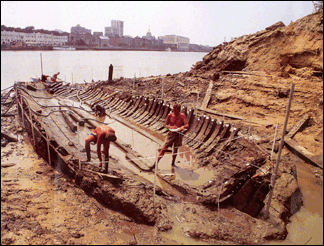

Parting the Waters
Scientists urge study of sunken ships, submerged settlements

Photo by Jonas Jordan/Society for Georgia Archeology
Archaeologists uncover the skeleton of an abandoned
boat discovered
on Hutchinson Island, just across the Savannah River from City Hall.
By Edward Fulford
(5/7/99 issue)
Old shipwrecks, buried civilizations, hidden links to a murky past buried in the watery depths.
Sound like a far-fetched tale of romantic fiction?
Maybe, but archaeologists would like to learn more about the reality of prehistoric habitation, ships either abandoned or sunk in wartime, and the history of life along Georgia's waterways.
According to several experts, that history will be lost without a concerted effort toward study and preservation of underwater archaeological sites.
"I think having an underwater program in Georgia that addresses the needs of submerged resources is critical," said Rita Elliott, current president of the Society for Georgia Archaeology. "We've never had one."
Elliott is employed by Southern Research based in Columbus. The company is under contract to the state Department of Natural Resources to investigate the condition of underwater archaeological sites in Georgia and programs other states are using to research and preserve similar sites elsewhere.
She said without a directed program to protect them, sites such as shipwrecks are suffering from looting and natural erosion. She added that for those sites at the bottom of lakes, rising and falling lake levels are also detrimental.
"The longer we wait, the faster we're losing our heritage," she said.
Elliott concedes that sites on land are easier to study, but stresses the validity of studying underwater sites.
"Just because it's underwater doesn't mean it's less valid from an educational point of view," she said. "Underwater sites are unique due to the fact that they do deal with water."
Not only shipwrecks, but also sites such as submerged docks and wharves can tell archaeologists much about commerce, agriculture and population centers, Elliott said.
John "Chip" Morgan, staff archaeologist for the Historic Preservation Division of the Georgia Department of Natural Resources said much of Georgia's early history is bound to the water, "especially on the coast, because it was such a cheap method of travel."
Elliott said there are also Indian villages that date back 10,000 to 14,000 years.
"They have immense opportunities to provide us with research that we can't find on land because they offer preservation of organic materials that you wouldn't get on dry land," she said. "Just where it is geographically might prove where greater populations of Indians were."
Elliott said the underwater sites are also better preserved because they're harder to loot.
Two Confederate ships lie in waters around Savannah. The C.S.S. Georgia rests in the Savannah Harbor, while the C.S.S. Nashville (later known as the Rattlesnake) is at the bottom of the Ogeechee River, just across from the site of Fort McAllister.
With a harbor deepening project already approved by the U.S. House of Representatives and awaiting clearance by the Senate, Elliott said the wreck of the C.S.S. Georgia might need to be raised before it suffers any more damage.
Daniel Brown, park manager at Fort McAllister State Park, said currently the state's plans for the Nashville are to leave it where it lies.
"Right now, the state doesn't bring up wrecks," Brown said. "It preserves them as-is underwater.
"Any time you bring wood or iron up that's been resting on the bottom, especially if there is saltwater involved, you have to do about a 10-year process in order to stabilize the wood and iron enough to put it on display."
Brown said without an organized effort, the necessary preservation of the shipwrecks and other sites won't happen.
"If you have an underwater archaeology program, such as a preservation lab that can treat the artifacts that are brought up, then archaeologists can go in and excavate the wrecks and bring the stuff up," he said. "As it is now, we don't have anywhere to store or to preserve the artifacts, so it's best for them to be left on the wrecks themselves."
But leaving the old ships in place opens up the possibility of sport divers retrieving bits and pieces from the wrecks.
"By doing that, they take off certain parts of the wrecks and leave the rest and it messes up the historical significance," Brown said. "That's why it's important for folks not to be diving on the wrecks unless they're trained archaeologists and have a place to send the stuff once it comes up."
Despite the challenges of preserving the warships, Morgan said the large boats, merchant vessels and Navy ships are well-documented in recorded histories.
"The thing we know so little about on a coast like Georgia's is the everyday traffic, the day-to-day transport of freight and passengers," he said. "Without a program looking for those kinds of resources and how they may have altered the coast and the culture, people don't realize how closely Georgia history was tied to the water."
For instance, Morgan said Darien was once a large logging town.
"At one time, Darien was a bustling hub, because of all these huge rafts of timber coming down the Altamaha," he said. "What did it look like 100 years ago when the ships were coming to pick up the timber and lumber? They were probably different from the docks that serve the shrimping boats now.
"It's those kinds of things that generally we don't know much about in Georgia."
Morgan said he would like to know more about how coastal and riverside cultures changed over time.
"To me, the docks, wharves, all that engineering and technology and the way it evolved with new technology, moving from sail to steam, there's not a whole lot that is known about Georgia maritime history," he said.
Morgan said archaeologists need to answer questions such as what was done to keep the channels clear and what lighthouse culture was like.
"What kind of person would go out into those moderately remote areas and spend his time doing that?" he said.
Morgan said the most important information that underwater and maritime archaeological efforts could give would be new insights into the everyday lives of Georgians from long ago, especially in regards to how things were constructed, or the "everyday architecture from the templates between the ears of the builders."
"The only way we're going to be able to find out about those boats and bateaux and docks (is if) we actually go out and find those resources," he said.
University of Georgia Archaeology Professor Dr. Ervan Garrison said there are plenty of places to search for submerged artifacts.
"Georgia's prehistoric shoreline was at least 60 miles farther out to sea than today's," he said. "Today's shoreline is only 6,000 years old."
Garrison said the state is studying an underwater archaeology program.
"The Department of Natural Resources Historic Preservation Division just this year recognized the state's deficiency in dealing with submerged cultural resources," Garrison said. "They have begun to solicit grants to develop a strategy to bring Georgia to a level comparable to other state programs such as North and South Carolina and Florida."
Still, Garrison said it will be a couple of years before any new program is implemented.
Check out more past feature stories
Home | Contact Us | Sitemap
| FAQ | Subscribe
| Survey
(c) Copyright 1999. The Georgia Guardian. All rights
reserved.
No photo may be reproduced without our written permission.